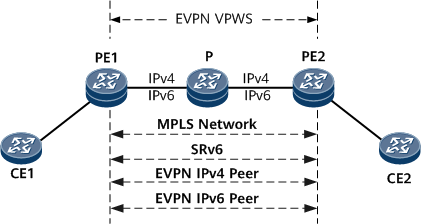Configuring EVPN VPWS over MPLS/EVPN VPWS over SRv6 Dual-Stack Tunnels
Currently, EVPN + SRv6 is a mainstream transport solution for 5G services. To prevent live network services from being affected, a new transport solution must be deployed based on the existing services on live networks. If a large number of EVPN VPWS over MPLS services exist on the live network, you can configure dual-stack to prevent traffic interruption caused by direct IPv4-to-IPv6 service switching when IPv4 and IPv6 networks coexist, facilitating evolution from EVPN VPWS over MPLS to EVPN VPWS over SRv6.
Usage Scenario
As IPv4 addresses are gradually exhausted, IPv6 network deployment becomes the trend. However, network evolution cannot be completed at one time, and IPv4 and IPv6 services will coexist for some time.
To ensure that existing services are not affected during the upgrade and evolution of existing networks, dual-stack tunnels must be used. The core idea of this mode is to configure EVPN VPWS over MPLS/EVPN VPWS over SRv6 dual-stack and apply priority-based route selection to enable PEs to preferentially select SRv6-based EVPN routes.

Pre-configuration Tasks
Before configuring EVPN VPWS over MPLS/EVPN VPWS over SRv6 dual-stack tunnels, complete the following tasks:
- Configure Layer 3 route reachability on the IPv4 network.
- Configure IPv6 IS-IS on PEs and Ps. For configuration details, see Configuring Basic IPv6 IS-IS Functions.
Procedure
- Configure EVPN VPWS over MPLS between PEs. For configuration details, see Configuring EVPN VPWS over MPLS Functions.
- Configure priority-based route selection on PEs.
Run the system-view command to enter the system view.
- Run the evpn vpn-instance vpn-instance-name vpws command to enter the view of an existing VPWS EVPN instance.
- Run the bestroute nexthop-priority ipv6 command to configure the device to preferentially select the routes with IPv6 next hop addresses after the routes learned by VPNv4 or VPNv6 are leaked to the EVPN instance.
- Run the quit command to return to the system view.
Run the commit command to commit the configuration.

To ensure service continuity in a scenario where IPv4 services need to smoothly evolve to IPv6 services, run the bestroute nexthop-priority ipv6 command to enable the device to advertise BGP EVPN routes carrying SIDs to both BGP EVPN IPv4 and BGP EVPN IPv6 peers, and then configure EVPN VPWS over SRv6.
- Configure EVPN VPWS over SRv6 between PEs. For configuration details, see Configuring EVPN VPWS over SRv6 BE or Configuring EVPN VPWS over SRv6 TE Policy.
Verifying the Configuration
- Run the display bgp evpn evpl command to check information about all EVPL instances.
- Run the display bgp evpn { all | route-distinguisher route-distinguisher | vpn-instance vpn-instance-name } routing-table [ { ad-route | es-route | inclusive-route | mac-route | prefix-route } prefix ] command to check BGP EVPN route information.
- Run the display segment-routing ipv6 local-sid end-dx2 evpl-instance evpl-id forwarding command to check SRv6 BE local SID table information.
- Run the display evpn vpn-instance [ name vpn-instance-name ] tunnel-info command to check information about the tunnel associated with an EVPN instance.
- Run the display evpn vpn-instance name vpn-instance-name tunnel-info nexthop nexthopIpv6Addr command to check information about the tunnel that is associated with a specified EVPN instance and matches a specified next hop.